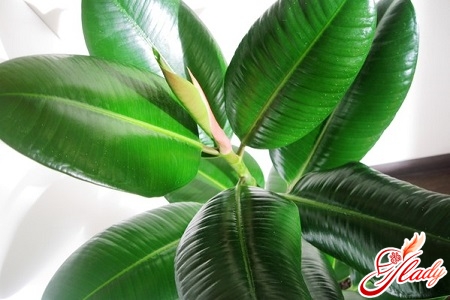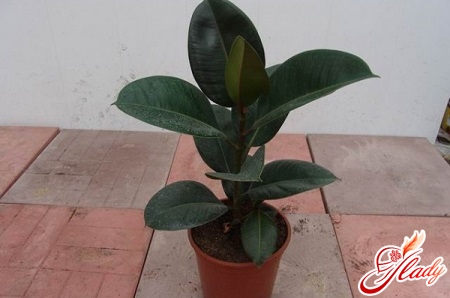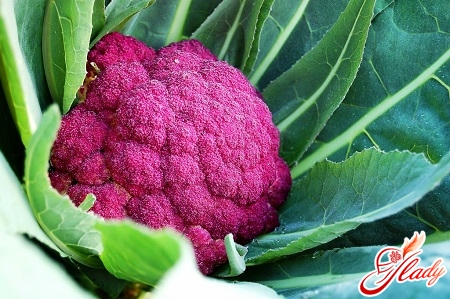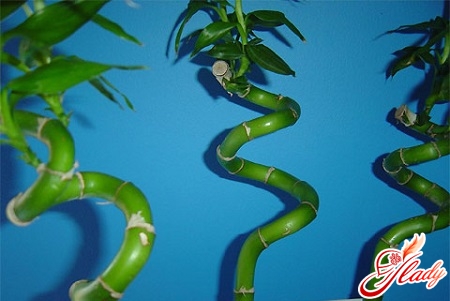
Ficus Robusta, or rubber plant, as it is also calledis called, can be considered the most unpretentious plant of all ficuses. And therefore, amateur flower growers are advised to start growing their collection of indoor flowers with this particular specimen. It fits perfectly into any interior, does not require a lot of time for maintenance and care. And easy reproduction will be an additional bonus for you. In addition, the rubber-bearing ficus, thanks to its large thick leaves, effectively cleans the air from harmful accumulations of phenol and benzene. And followers of the teachings of Feng Shui recommend purchasing this tree to people prone to various excesses. For example, spendthrifts or people with a big appetite. The plant has a beneficial effect on the overall emotional atmosphere in the house; the main purpose of this ficus according to Feng Shui is to cleanse the aura of the house and protect the home from evil spirits.

Rules for keeping Robusta
In the maintenance and care of the Ficus Robusta it is necessaryadhere to the generally accepted rules recommended for indoor plants. Below we will focus on the main requirements that you need to pay attention to.
- Lighting
It must be said that, unlike mosttypes of ficus, Robusta is not so demanding of light and feels great next to a shaded window or on a windowsill on the north side. But of course, you can’t leave the plant without any light at all. The lack of sun can easily be compensated for by additional artificial lighting. Most likely, this will not be necessary, the ficus easily adapts to the existing conditions. The only thing that can spoil the juicy beautiful leaves is direct sunlight: they leave burns, which leads to yellowing and further leaf fall.
- Temperature
Normal room temperature is optimal formaintenance of rubber ficus. Ideal care involves keeping the plant at a temperature of 18 - 25 ° C. However, never place the pot with the plant near hot radiators. Hot dry air is the worst "punishment" for ficus. Moisture from the leaves evaporates quickly, and the plant becomes dehydrated. Too low a temperature can cause the leaves to fall off. In general, the plant tolerates gradual adaptation to temperature changes quite well. For example, this happens in spring and autumn, when you move the tree to the balcony or to the garden and back.
- Humidity
One of the necessary conditions thatprovides proper care and further favorable growth of the tree, - humidity above 50%. As a rule, and especially in winter, in apartments the humidity of the surrounding air barely reaches 35 - 40%. Fortunately, this is easy to fix. Moreover, low humidity is also undesirable for people whose body water content is 65 - 75%. Buy a special humidifier; as a last resort, spray the plant more often, give it a shower, wipe the leaves with a damp cloth. Providing optimal humidity, as a reward for your efforts you will get a ficus with juicy healthy leaves, which is what it is valuable for.
- Watering
The tree needs to be watered all year round, even in winter.reducing the watering activity, and in summer, on the contrary, increasing its frequency. It is better to use settled water at room temperature. Before watering the tree again, always let the soil dry out a little. Do not overwater the ficus, this is fraught with root rot and leaf disease. If prolonged and repeated flooding does occur, try replanting the tree in different soil. In advanced cases, the ficus may not need further care. Stick to the golden mean when watering - it is better to water frequently and moderately than rarely and abundantly.
- Fertilizer
It is necessary to fertilize Ficus Robusta during the periodvegetation, that is, during the active growth of leaves. As a rule, this happens with the first spring sun and until mid-autumn. Nitrogen fertilization has the best effect on the active growth of leaves and promotes tree branching. It will be enough to water the plant with a diluted fertilizer solution every ten to fifteen days.
- Transfer
Transplantation of young ficus is carried out in springor in early summer, once every one or two years. Everything depends on the intensity of growth of the tree itself and its root system. Long-livers are rarely replanted, and if the specimen is large, then only the top layer of soil is replaced. The pot for replanting should not be much larger than the previous one, only an increase of two to three centimeters in diameter is allowed. The substrate for replanting must be nutritious; the requirements for it do not differ from the requirements for substrates for other varieties of ficus. High-quality drainage is required. In general, rubber ficus takes root in new soil without any particular difficulties and immediately begins to grow actively. Young shoots do not require special care, they grow quite quickly.
- Reproduction
Propagation by cuttings is the easiesta way to get a new ficus. The tops of the shoots are used, which are placed in the ground or in water with the addition of a root growth stimulator. For successful rooting, it is necessary to increase the temperature of the content, for which you need to cover the young shoot with a jar or a bag. Naturally, it is necessary to provide ventilation in this mini-greenhouse. Reproduction by air layering is allowed, which ensures that you get a large ficus.
Diseases and pests of ficus
Fortunately, this representative of the familyMulberry is not a "weakling", and therefore resistant to diseases and pests. What you need to pay attention to is yellowing or shedding of leaves. If this happens, then review the conditions of its maintenance. Perhaps the tree is in a draft or does not have enough moisture. Perhaps the ficus needs to be moved away from a sunny window or, conversely, add lighting. But brown wet spots on the leaves indicate excessive watering. A putrid smell from the pot indicates a disease of the root system. There was a sharp shedding of leaves - the plant is under stress. Dry warm air can attract pests such as spider mites and scale insects. They mainly settle on the inside of the leaf, forming colonies. They feed on the juice of the leaves, immersing sharp proboscis in the tissues of the plant, and leave behind a sticky liquid, which provokes fungal diseases. For example, black sooty fungus may appear.
Prevention of diseases
However, it is not difficult to save your pet from all possible pests and avoid diseases, and the main way to prevent their occurrence is elementary prevention. What will need to be done?
- Arrange quarantines for all newly acquired plants;
- Periodically conduct visual inspection of the ficus;
- Comply with all basic rules of care;
- Weekly, treat the leaves with a damp cloth using soapy water and ordinary water alternately;
- If possible (at least once a month) organize for the plant a shower with warm water.
As we have already said, the rubber plant isThe plant is unpretentious. By devoting a minimum of time and a maximum of love to it, you will gain peace, balance and a lot of positive emotions given to you by a majestic beauty with powerful leaves, whose name is Ficus Robusta.









